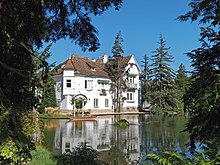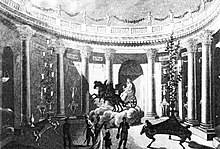Schönau Castle (Lower Austria)
The Schoenau Castle is located in the town of Schonau an der Triesting in the industrial area of Lower Austria .
history
The original castle was built in the 11th century as a fortress to protect the newly settled Bavarians. During the second Turkish siege in 1683, the moated castle was assigned to the surrounding population for protection. However, nothing remains of the original construction. Remnants of the wall on the outside of the orchard are likely from this time.
Today's Schönau Palace was built on the site in the years after 1796. It was built by Baron Peter von Braun , who was one of the richest men in Austria at the time. Austria's first gas lighting was installed in the castle. An underground grotto system around the Temple of the Night (remains are under monument protection ) and a fairy tale park (not preserved) were also created around the castle in the park . The first was Braun's sign of his membership in a Masonic lodge in Vienna, the second an expression of the partly rococo , partly romanticizing park concept. The Temple of the Night is closely related to the Magic Flute . The rock bridge next to it ( listed ) and the Löwentor at the east entrance to the property ( listed in Günselsdorf ) also date from this time .
The property changed hands a few times over the years. It was also owned by Johann von Liechtenstein , Napoleon's brother Jérôme Bonaparte , Emperor Franz Joseph I or Archduke Otto of Austria , who had it rebuilt and rebuilt in neo-late Gothic forms. For the subsequent owner Elisabeth Marie of Austria , the red Archduchess , further redesigns were made.
During the Second World War , offices of the German Wehrmacht were housed in the castle, which is why it was under Soviet USIA administration after the war . In 1951 the castle, which was occupied by soldiers of the Red Army until 1953, came into the ownership of Alexandrine Baroness Happack, nee. Countess Demblin .
In 1961, Happack leased the property to the Dutchman WC Holwerff . He left it (to the federal authorities) in the years 1965–1973 for use as an emigrant camp for Soviet Jews who emigrated to Israel . Before it was closed as a result of the Marchegg hostage-taking, around 70,000 emigrants had passed through the camp under the supervision of the Jewish Agency .
Until he moved to Wiener Neustadt between 1978 and 1992, the Gendarmerie Task Force , now Task Force Cobra , was housed on the property.
The park is one of the most important garden architectural monuments in Austria and is under monument protection ( No. 21 in the appendix to Section 1, Paragraph 12 of the DMSG and in the list of monuments ) and is also dedicated as a natural monument ( NDM BN-118 , 1987). The old trees are protected and the landscape garden is left close to nature.
The entire castle property is owned by the Sequoia Private Foundation. There are restored guest apartments in the historic hunting lodge in the castle area. Guided tours of the remains of the Temple of the Night were also offered. The park was rented by the village renewal association Erde Nakula "so that it remains open to the public". After disputes over tenancy law with the manager Michael Kremsner, the Nakula association got out of the lease agreement. The park is now no longer open to the public, but only to house guests in the hunting lodge (as of 2015). At the entrance on the Günselsdorf side there is a small area of the park around a coffee house (Café Löwentor) to enter.
The Waldorf kindergarten is located in the fort, the original location of the moated castle, and the residence of the Rudolf Steiner Country School has been on the area of the Paradehof for 25 years .
Remarks
- ↑ Koloman Count Nako de Nagy Szent Miklos, owner of the palace from 1851 to 1860, had the roof removed and everything that could be used removed from the temple rooms; the property was subsequently left to decay. - Hauer: Schönau , p. 62.
- ↑ Archduke Otto (1865–1906) took over Schönau in 1896, the year the Kottingbrunn obstacle course was opened , and for this reason moved his horse racing stable from Oberweiden to Schönau. - See: Fonograf. (...) Archduke Otto has his racing team (...). In: Allgemeine Sport-Zeitung , year 1896, No. 52/1896, July 23, 1896 (XVII. Year), p. 810, top right. (Online at ANNO ). .
- ↑ or also: August von Hoolwerff. - Hauer: Schönau , p. 146.
- ↑ At that time about 150 men of the special unit Scorpio , a name that was derived from the former radio call name by outsiders . - Hauer: Schönau , p. 146.
literature
- Josef Hauer (among others): The community of Schönau an der Triesting and its districts in the past and present . 1st edition, community Schönau an der Triesting, Schönau an der Triesting 1979, OBV , ÖNB .
Web links
- Schönau Castle . In: schloss-schoenau.at
- History of Schönau Palace Park and Schönau Palace . ( Memento from January 21, 2005 in the Internet Archive ) In: www.unet.univie.ac.at .
- Story . In: schoenautriesting.at
- Entry via Schönau on Burgen-Austria
Individual evidence
- ↑ a b c d e Eva Berger: Historic Gardens of Austria: Gardens and parks from the Renaissance to around 1930 . tape 1 Lower Austria, Burgenland . Böhlau Verlag, Vienna 2002, ISBN 978-3-205-99305-6 , Schönau an der Triesting, Schloßpark , p. 529 f . ( limited preview in Google Book search).
- ↑ a b Temple of the Night & Park. schloss-schoenau.at, accessed November 21, 2015.
- ↑ Schönau Palace - landscape garden. ( Memento of the original from October 19, 2013 in the Internet Archive ) Info: The archive link was inserted automatically and has not yet been checked. Please check the original and archive link according to the instructions and then remove this notice. schloss-schoenau.at, accessed on October 18, 2013 (link no longer available 11/2015).
- ^ Hauer: Schönau , p. 69.
- ^ Hauer: Schönau , p. 146.
- ↑ Earth Nakula Schönau / Tr. In: www.schoenautriesting.at
- ↑ (...) Trees are protected . In: noe.orf.at , accessed on November 20, 2010.
- ^ Rudolf Steiner Country School Schönau (waldorf-schoenau.at)
Coordinates: 47 ° 56 ′ 18 ″ N , 16 ° 15 ′ 5 ″ E



